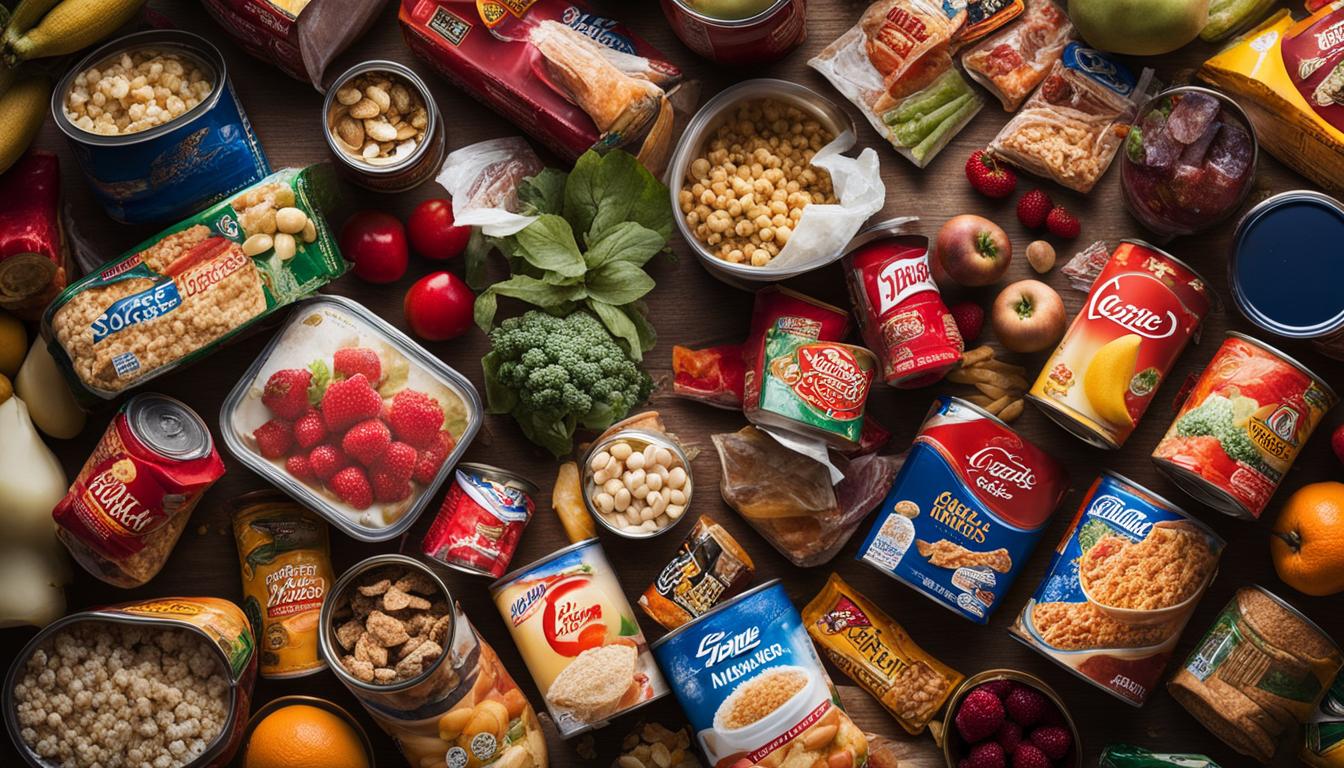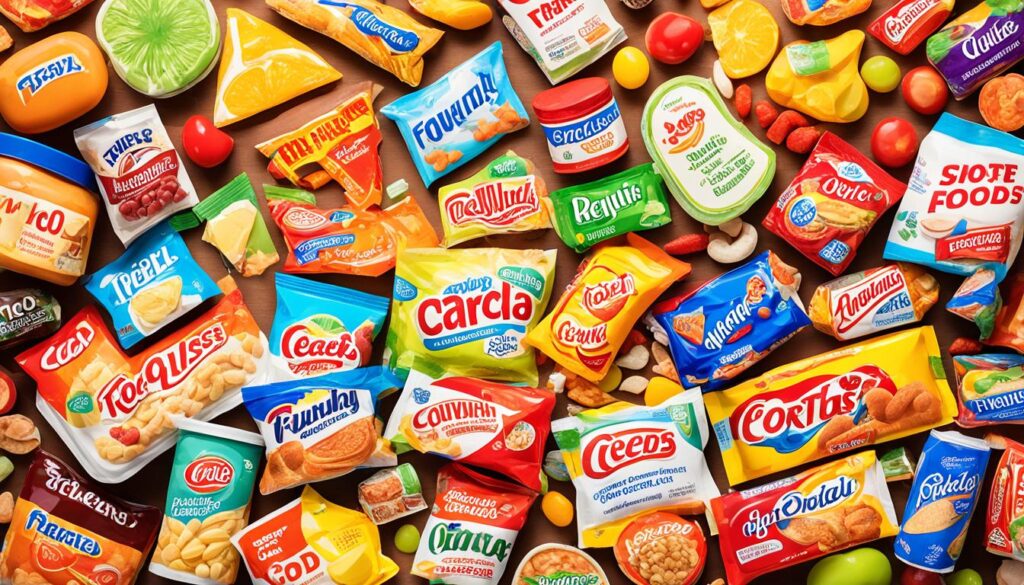
Hidden Dangers: Household Food Items Unhealthy or Risky
Welcome to our eye-opening exploration into the hidden dangers lurking in your pantry and kitchen. While household food items are often perceived as safe and nourishing, the reality is that some may pose health risks. In this section, we will delve into the potentially risky and unhealthy ingredients found in these products, shedding light on the harmful food products you may unknowingly be consuming.
Key Takeaways:
- Household food items may contain hidden risks and unhealthy ingredients.
- Some pantry staples can be dangerous or unhealthy when consumed regularly.
- Processed foods often contain artificial additives, preservatives, and excessive sugar or sodium.
- Misleading labels on food packaging can hide the truth about ingredients and health risks.
- Making informed choices and opting for safer alternatives can help reduce potential harm.
Common Culprits: Unhealthy Pantry Items to Avoid
When it comes to maintaining a healthy lifestyle, the contents of your pantry play a crucial role. It’s important to be aware of the common culprits hiding in your pantry that can be detrimental to your health. By understanding the dangerous ingredients found in various food items, you can make informed choices to protect yourself and your loved ones.
Below are some hazardous pantry items that you should consider eliminating from your shopping list:
| Unhealthy Pantry Items | Dangerous Ingredients | Health Risks |
|---|---|---|
| Sugary Cereals | High Fructose Corn Syrup, Artificial Sweeteners | Increased Risk of Obesity, Type 2 Diabetes |
| Processed Meats | Sodium Nitrate, Trans Fats | Higher Risk of Heart Disease, Stroke |
| Artificial Sweeteners | Aspartame, Sucralose | Potential Negative Impact on Gut Health, Weight Gain |
| Trans Fats | Partially Hydrogenated Oils | Increased Risk of Heart Disease, Inflammation |
| Sugary Drinks | High Fructose Corn Syrup, Artificial Colors | Weight Gain, Tooth Decay, Increased Diabetes Risk |
By avoiding these unhealthy pantry items, you can take a significant step towards improving your overall well-being and reducing the risk of various health issues.
Dangerous Ingredients in Food: Know What to Look For
Understanding the dangerous ingredients commonly found in food is essential for making informed choices. Here are a few hazardous ingredients to watch out for:
- High Fructose Corn Syrup: Linked to increased risk of obesity, diabetes, and other metabolic disorders.
- Sodium Nitrate: Found in processed meats and associated with a higher risk of heart disease and certain cancers.
- Trans Fats: Artificially produced fats that contribute to heart disease, inflammation, and other health problems.
- Artificial Sweeteners: Can negatively impact gut health, potentially leading to weight gain and metabolic disturbances.
By familiarizing yourself with these dangerous ingredients, you can make more informed decisions while grocery shopping and ensure the healthiest options for you and your family.
“It’s crucial to read food labels carefully and understand what ingredients you’re consuming. Don’t let unhealthy pantry items sneak into your shopping cart.” – Dr. Anna Johnson, Nutritionist
Processed Foods: The Hidden Dangers
When it comes to processed foods, convenience often comes at a cost. These widely available food products may seem convenient and tasty, but they often harbor hidden dangers that can pose significant risks to your health.
Processed foods are typically loaded with unhealthy ingredients, including artificial additives, preservatives, and excessive amounts of sugar or sodium. These ingredients not only compromise the nutritional value of the food but also contribute to various health issues when consumed regularly.
Artificial additives such as artificial colors, flavors, and sweeteners are commonly found in processed foods to enhance taste and appearance. However, these additives have been linked to adverse effects on overall health, including hyperactivity in children and an increased risk of chronic diseases.

Preservatives are another concerning component in processed foods. They are added to prolong shelf life and prevent the growth of harmful bacteria, molds, and yeasts. However, some preservatives, such as BHA and BHT, have been linked to potential carcinogenic effects and other health concerns.
The excessive amounts of sugar and sodium often present in processed foods can have detrimental effects on your health. High levels of sugar contribute to obesity, diabetes, and dental problems, while excessive sodium intake can lead to high blood pressure and an increased risk of heart disease.
Understanding the hidden dangers of processed foods is crucial for making informed dietary choices. By prioritizing whole, unprocessed foods like fruits, vegetables, whole grains, and lean proteins, you can significantly reduce your intake of unhealthy ingredients and improve your overall well-being.
Take control of your health by carefully reading food labels, opting for products with minimal or no additives, and preparing meals from scratch whenever possible. By doing so, you can minimize your exposure to processed foods and create a healthier, more balanced diet for yourself and your family.
Misleading Labels: Uncovering the Truth
When it comes to food packaging, what you see isn’t always what you get. Misleading labels and deceptive marketing tactics are prevalent in the food industry, making it essential for consumers to be informed and vigilant. By uncovering the truth behind these misleading labels, we can make better choices for our health and well-being.
The Hidden Risks of Misleading Labels
Many food products claim to be “healthy,” “natural,” or “organic,” but these labels can be misleading. Food manufacturers often use deceptive marketing techniques to make their products appear more nutritious or wholesome than they actually are. This leaves consumers unaware of the hidden risks and potential health consequences.
“Don’t be fooled by the marketing tactics employed by food companies. Take a closer look at the labels and understand what lies beneath.”
One common example of deceptive labeling is the use of terms like “low-fat” or “reduced-sugar.” While these labels may sound promising, the products can still be high in unhealthy fats, artificial sweeteners, or excessive sodium. Consequently, consumers may unknowingly consume these ingredients, putting their health at risk.
Unveiling Hidden Ingredients
Reading food labels is crucial for uncovering hidden risks and unhealthy ingredients. It’s essential to look beyond the front-of-package claims and examine the list of ingredients. Often, you’ll find additives, preservatives, and artificial flavors and colors concealed in seemingly “healthy” or “natural” products.
To make informed choices, familiarize yourself with commonly misused terms and understand their true meanings. Terms like “all-natural” or “made with real fruit” may seem harmless, but they can be deceptive marketing ploys. Manufacturers rely on these vague terms to disguise the presence of artificial additives and sweeteners.
Educating Yourself for Better Choices
Learning how to read labels effectively is the key to safeguarding your health and avoiding hidden risks. Here are some tips:
- Focus on the ingredient list: Pay attention to the first few ingredients, as they make up the majority of the product. Avoid items with unhealthy fats, excessive sugar, or artificial additives.
- Watch out for misleading claims: Be skeptical of terms like “natural,” “healthy,” or “wholesome” if the ingredients list doesn’t align with them.
- Look for certifications: Seek out products with reputable certifications, such as USDA Organic or Non-GMO Project Verified, to ensure they meet specific standards.
By educating yourself about deceptive marketing tactics and hidden risks, you can make more informed choices for yourself and your family. Don’t let misleading labels sway your decisions; take control of your health by deciphering the truth behind the packaging.

| Common Deceptive Terms | What They Really Mean |
|---|---|
| “All-Natural” | This term has no legal definition and can be used on products containing artificial additives. |
| “Made with Real Fruit” | While some real fruit may be present, the product can still contain added sugars and artificial flavors. |
| “Low-Fat” | The product may be low in fat, but it can still be high in sugar, sodium, or artificial ingredients. |
| “Organic” | A product labeled “organic” must meet specific USDA standards and contain at least 95% organic ingredients. |
Safer Alternatives: Making Healthier Choices
When it comes to stocking your pantry, making healthier choices is essential for maintaining a well-balanced diet and reducing potential health risks. By exploring alternatives to unhealthy food items and discovering nourishing and safe pantry staples, you can prioritize your health and the well-being of your loved ones.
Opt for Safer Alternatives
Choosing safer alternatives is the first step towards creating a healthier pantry. Look for natural and organic options that provide nutrient-rich alternatives to processed and unhealthy foods. These alternatives can help you avoid harmful ingredients and excessive additives that may pose risks to your health. Make a conscious effort to read labels and opt for products that prioritize quality and nutrition.
Discover Healthier Pantry Staples
Stock up on pantry staples that promote overall well-being and support a healthier lifestyle. By incorporating these nourishing ingredients into your meals, you can enjoy the benefits of a well-rounded diet without sacrificing taste or convenience. Consider the following pantry staples:
| Pantry Staple | Benefits |
|---|---|
| Whole grains | Rich in fiber, vitamins, and minerals for improved digestion and sustainable energy. |
| Legumes | Excellent source of plant-based protein, fiber, and essential nutrients. |
| Herbs and spices | Enhance flavor without excessive salt or unhealthy additives. Many offer antioxidant and anti-inflammatory properties. |
| Healthy oils | Choose options such as olive oil or coconut oil that provide essential fatty acids for heart health. |
| Nuts and seeds | Packed with healthy fats, protein, and vitamins, they make for a satisfying and nourishing snack. |
| Fresh fruits and vegetables | These provide essential vitamins, minerals, and antioxidants for a well-rounded diet. |
Make Informed Choices
Be proactive in making informed choices for your pantry. Keep in mind that healthier options may require a bit more effort in meal planning and preparation, but the long-term benefits are worth it. Explore healthy recipes, experiment with new ingredients, and educate yourself about nutritional values. By doing so, you can take control of your food choices and prioritize the well-being of yourself and your loved ones.
With the right knowledge and a commitment to healthier choices, you can transform your pantry into a haven of nourishment and well-being. Embrace safer alternatives, incorporate healthier pantry staples, and enjoy the numerous benefits of a balanced diet. By taking these steps, you can safeguard your health and promote a healthier lifestyle for years to come.
Conclusion
In conclusion, it is crucial to be aware of the potential risks associated with certain household food items. By understanding the hidden dangers, misleading labels, and unhealthy ingredients, you can make informed choices to protect your health and the well-being of your loved ones.
Take proactive steps to create a safer and healthier pantry by opting for alternative options and making knowledgeable decisions while shopping for food. Look for products that prioritize natural and organic ingredients over processed and artificial additives.
Remember, your food choices have a significant impact on your overall health, and being mindful of the ingredients you consume can help reduce the risk of harmful health effects. By prioritizing safer alternatives and avoiding dangerous or unhealthy household food items, you can take control of your diet and promote a healthier lifestyle.




